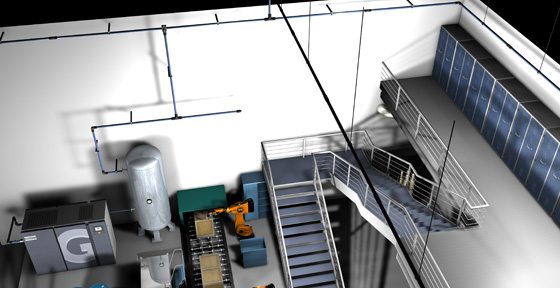Inefficient compressed air distribution systems result in higher energy bills, lower productivity and poor air tool performance. Piping systems more than five years old have been shown to exhibit leaks of up to 25 percent, yet many facilities are slow to upgrade equipment to the latest technology. Additionally, undersized or oversized piping, poorly configured systems or clogged filters can create significant artificial demand.
Designing an Efficient Compressed Air Distribution Network
How do you know if your compressed air distribution network is efficient? Efficient networks include the following:
- Low pressure drop between the compressor and point of consumption.
- Minimum leakage from the distribution piping.
- Efficient condensate separation if a compressed air dryer is not installed.
This checklist primarily applies to the main piping, and to the planned compressed air consumption for current as well as future needs. Consider the cost of rebuilding an entire distribution network at a later date, and getting it right the first time becomes even more important.
For the most efficient materials, choose a lightweight, modular piping system that can be taken apart and reconfigured if the compressed air system grows or changes over time. Aluminum piping virtually eliminates the corrosion seen in black iron or galvanized steel systems, and the smooth inner bore allows air to pass through the pipe with less resistance, reducing pressure drops. Plus, installation of aluminum piping takes about one-third of the time it takes to install a traditional system.
Reducing Pressure Drops through Proper Dimensioning
Fixed compressed air distribution networks should be dimensioned so that the pressure drop in the pipes does not exceed 0.1 bar between the compressor and the most remote point of consumption. The largest pressure drops frequently occur at connections of flexible hoses, hose couplings and other fittings throughout the compressed air distribution network, so these areas should be carefully examined and properly dimensioned as well.
Try a Closed Loop Ring Piping System
The most efficient piping system involves a closed loop ring line around an area in which air consumption will take place. Branch pipes are then run from the loop to the various consumption points. This provides uniform compressed air supply, despite heavy intermittent usage, as the air is led to the actual point of consumption from two directions.
This system design can be used for all installations, except installations where points of large air consumption are located at a great distance from the compressor room. In that scenario, a separate main pipe is then routed to the furthest point.
To learn more about Atlas Copco’s aluminum piping systems, simply contact us by filling out our Request a Quote form. You may also be interested in the following articles:
- Innovative Energy Recovery Project Cuts Local College’s Heating Bill
- Rick Dore to Sign Autographs at Atlas Copco SEMA 2015 Booth #10209
- Bigger Doesn’t Always Mean More Powerful
Source: Compressed Air Blog


